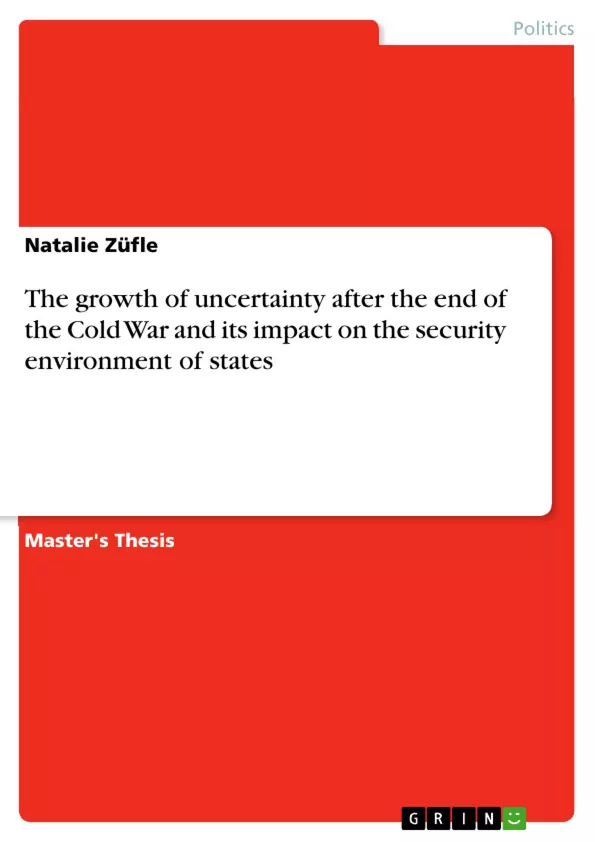Uncertainty has grown considerably after the end of the Cold War. In the place of one big threat a plenitude of many “smaller” and more incalculable risks superseded. New dangers have emerged or become more salient as compared to former times (like environmental issues, IT problems, or economic crises), while “old” ones have not entirely vanished. The risks emanating from WMDs or the threat of wars remain existent, albeit sometimes in an altered form.
Several factors have contributed to the alteration of the threat and risk pattern: in the main, the transition to a multipolar world order, the processes of globalization, and last but not least the diminishing importance of borders and of the sovereign nation-state as such are decisive. Hence, the vulnerability of civil society has increased considerably, as open societies are more risk-prone.
In reaction to these developments, academics and politicians have refined the traditional concept of national security into a broader notion, considering a multitude of aspects affecting the safety of the human being as such. In consequence the classical security architecture is being adapted bit by bit to the conditions of the 21st century. On each level, i.e. the national, regional as well as international layers, diverse mechanisms have been developed – as exemplary illustrated with reference to the transnational danger of terrorism.
Inhaltsverzeichnis (Table of Contents)
- A. THE GROWTH OF UNCERTAINTY AFTER THE END OF THE COLD WAR
- 1. Causes for the growth of uncertainty
- 1.1. Systemic heritage and transformation
- 1.2. Full-scale globalization
- 1.3. The change of statehood
- 2. New dangers in brief
- 2.1. Intra-state conflicts
- 2.2. Poverty
- 2.3. Resource conflicts
- 2.4. Economic risks
- 2.5. Environmental degradation
- 2.6. Global arms trade and proliferation of WMD
- 2.7. International terrorism
- 2.8. IT dangers
- 2.9. Pandemics
- B. THE IMPACT OF GROWING UNCERTAINTY ON THE SECURITY ENVIRONMENT OF STATES
- 1. A new concept of security – human security
- 2. Changing security policy
- 2.1. National efforts
- 2.2. Regional measures
- 2.3. Global solutions
Zielsetzung und Themenschwerpunkte (Objectives and Key Themes)
This master's thesis explores the growth of uncertainty following the end of the Cold War and its impact on the security environment of states. It delves into the causes of this heightened uncertainty, examining factors such as globalization, systemic transformations, and the evolving nature of statehood. The thesis also investigates the implications of this uncertainty for security policy, analyzing national, regional, and global responses to the challenges it presents.
- The impact of the Cold War's end on global security
- The emergence of new security threats and challenges
- The evolution of security policy in response to uncertainty
- The role of globalization in shaping security landscapes
- The changing nature of statehood in a multipolar world
Zusammenfassung der Kapitel (Chapter Summaries)
The first chapter delves into the causes behind the burgeoning uncertainty in the post-Cold War era. It analyzes the systemic legacy and transformation of the international system, the ramifications of full-scale globalization, and the changing nature of statehood in a multipolar world. The second chapter explores a range of new security threats that have emerged, including intra-state conflicts, poverty, resource conflicts, economic risks, environmental degradation, global arms trade, international terrorism, IT dangers, and pandemics.
Schlüsselwörter (Keywords)
The primary focus of this work centers on the concepts of uncertainty, security, statehood, globalization, and the international system. It examines the impact of these factors on the security environment of states, exploring the evolution of security policy in response to emerging threats and challenges.
- Quote paper
- Natalie Züfle (Author), 2009, The growth of uncertainty after the end of the Cold War and its impact on the security environment of states, Munich, GRIN Verlag, https://www.grin.com/document/180017



